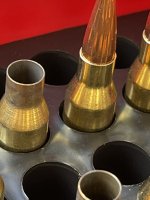hi everyone first time poster , i got a new barrel for my first bolt gun . Got the addiction and have been heavily chasing accuracy . So when this barrel arrived it took me a bit to get it installed and i checked it out with a bore scope , i saw chatter on the neck , but i also saw 2 grooves on the side wall about 1/4 an inch down from the neck around the circumference . I went and put some rounds through it and it shot very well . I was getting sub half moa with my reloads with no load development . But i noticed it was leaving a ring on the brass in the spot of the grooves that was deep enough to feel with your fingernail .
I reached out to the smith who made the barrel and asked if i should try and polish it up or what and he said i could try or if i felt it needed replacement he would be happy to swap it out as well . I told him i would try again after giving it a light touch up .
So i hit the chamber with some red then green scotch brite on a wooden dowel . The grooves looked a but better and the sharp edges had been dulled but they were still there . The chatter on the neck was basically gone .
So today i took it out and shot again it shot incredible , one half moa and 2 sub quarter moa groups . The markings on the brass were still there though only part way around the brass not a full circle . I just purchased a bunch of new lapua brass i dont want to screw up . But i also do not want to send back this barrel that shoots so well .
The way i see it i have three options
1- polish it further ( pros and cons )
2- ignore it ( will this lead to decreased brass life , inconsistency with ammo after a few reloads ? )
3- send it back
Anyone especially smiths or barrel makers that might have any advice i would appriciate it .
I reached out to the smith who made the barrel and asked if i should try and polish it up or what and he said i could try or if i felt it needed replacement he would be happy to swap it out as well . I told him i would try again after giving it a light touch up .
So i hit the chamber with some red then green scotch brite on a wooden dowel . The grooves looked a but better and the sharp edges had been dulled but they were still there . The chatter on the neck was basically gone .
So today i took it out and shot again it shot incredible , one half moa and 2 sub quarter moa groups . The markings on the brass were still there though only part way around the brass not a full circle . I just purchased a bunch of new lapua brass i dont want to screw up . But i also do not want to send back this barrel that shoots so well .
The way i see it i have three options
1- polish it further ( pros and cons )
2- ignore it ( will this lead to decreased brass life , inconsistency with ammo after a few reloads ? )
3- send it back
Anyone especially smiths or barrel makers that might have any advice i would appriciate it .


